Deficit Irrigation Using Saline Water of Fruit Trees under Water Scarcity Conditions of Southern Tunisia
Abstract
:1. Introduction
2. Materials and Methods
- Full irrigation (FI), where trees were irrigated to provide them with their full water requirement based on computing crop evapotranspiration (ETc);
- Moderate (DI75) and severe (DI50) deficit irrigation, where 75% and 50% of ETc were covered by irrigation, respectively;
- Grower’s irrigation program (FM), which consisted in supplying fixed amounts on a weekly basis.
3. Results and Discussion
3.1. Soil Water Balance
3.2. Soil Salinity
3.3. Yield and Fruit Quality
3.4. Water Productivity
3.5. Economic Evaluation
4. Conclusions
Author Contributions
Funding
Institutional Review Board Statement
Informed Consent Statement
Data Availability Statement
Acknowledgments
Conflicts of Interest
References
- Topak, R.; Süheri, S.; Acar, B. Effect of different drip irrigation regimes on sugar beet (Beta vulgaris L.) yield, quality and water use efficiency in Middle Anatolian, Turkey. Irrig. Sci. 2011, 29, 79–89. [Google Scholar] [CrossRef]
- Fernandes-Silva, A.; Oliveira, M.; Paço, T.A.; Ferreira, I. Deficit Irrigation in Mediterranean Fruit Trees and Grapevines: Water Stress Indicators and Crop Responses. In Irrigation in Agroecosystems; Gabrijel, O., Ed.; IntechOpen: Rijeka, Croatia, 2018; Volume 24, pp. 1–24. [Google Scholar] [CrossRef] [Green Version]
- Geerts, S.; Raes, D. Deficit irrigation as an on-farm strategy to maximize crop water productivity in dry areas. Agric. Water Manag. 2009, 96, 1275–1284. [Google Scholar] [CrossRef] [Green Version]
- Ghrab, M.; Masmoudi, M.M.; Ben Mechlia, N. Water productivity in fruit trees orchards under water Scarcity. Acta Hortic. 2017, 1150, 317–332. [Google Scholar] [CrossRef]
- Naor, A. Irrigation scheduling and evaluation of tree water status in deciduous orchards. Hortic. Rev. 2013, 32, 111–166. [Google Scholar]
- Manuel, L.; Mónica, E.; Luca, T.; Ignacio, J.L.; Francisco, O.; Elías, F. Yield response of almond trees to transpiration deficits. Irrig. Sci. 2018, 36, 111–120. [Google Scholar] [CrossRef]
- Garcia-Tejero, I.; Duran, Z.V.H.; Jimenez, B.J.A.; Muriel, F.J.L. Improved water-use efficiency by deficit-irrigation programmes: Implications for saving in citrus orchards. Sci. Hortic. 2011, 128, 274–282. [Google Scholar] [CrossRef]
- Mahmoudzadeh Varzi, M.; Trout, T.; DeJonge, K.; Oad, R. Optimal Water Allocation under Deficit Irrigation in the Context of Colorado Water Law. J. Irrig. Drain. Eng. 2019, 145, 05019003. [Google Scholar] [CrossRef]
- Galindoa, A.; Collado-Gonzálezb, J.I.; Griñánc, I.; Corelld, M.; Centenof, A.; Martín-Palomod, M.J.; Giróne, I.F.; Rodríguezh, P.; Cruzh, Z.N.; Memmif, H.; et al. Deficit irrigation and emerging fruit crops as a strategy to save water in Mediterranean semiarid agrosystems. Agric. Water Manag. 2018, 202, 311–324. [Google Scholar] [CrossRef]
- Miguel Costa, J.; Ortuno, M.F.; Chaves, M.M. Deficit Irrigation as a Strategy to Save Water: Physiology and Potential Application to Horticulture. J. Integr. Plant Biol. 2007, 49, 1421–1434. [Google Scholar] [CrossRef]
- Masmoudi-Charfi, C.; Ayachi-Mezghani, M.; Gouiaa, M.; Laabidi, F.; Ben Reguaya, S.; Ouled Amor, A.; Bousnina, M. Water relations of olive trees cultivated under deficit irrigation regimes. Sci. Hortic. 2010, 125, 573–578. [Google Scholar] [CrossRef]
- Hammami, A.; Mellouli, J. Drip Irrigation Scheduling of Citrus Orchard in Tunisia. In Proceedings of the 21st ICID International Congress Of Irrigation and Drainage, Teheran, Iran, 15–23 October 2011; pp. 1–14. [Google Scholar]
- Mabrouk, H. The use of water potentials in irrigation management of table grape grown under semi-arid climate in Tunisia. J. Int. Sci. Vigne Vin 2014, 48, 123–133. [Google Scholar]
- Mahjoub, I.; Zitouna-Chebbi, R.; Mekki, I.; Ben Mechlia, N. Assessing irrigation scheduling by FAO method using soil-plant atmosphere water stress indicators on four orange cultivars. Acta Hortic. 2015, 1150, 139–144. [Google Scholar] [CrossRef]
- Colauto Stenzel, N.M.; Vieira Janeiro Neves, C.S.; Marur, C.J.; dos Santos Scholz, M.B.; Gomes, J.C. Maturation curves and degree-days accumulation for fruits of ‘folha murcha’ orange trees. Sci. Agric. 2006, 63, 219–225. [Google Scholar] [CrossRef] [Green Version]
- Janez, H.; Rajko, V. Impacts of climate change on fruit physiology and quality. In Proceedings of the 50th Croatian and 10th International Symposium on Agriculture, Opatija (Hrvatska), Croatia, 16–20 February 2015. [Google Scholar]
- Fiorella, S.; Francesco, I.; Simona, C.; Alberto, C.; Giancarlo, R. Response of Orange Trees to Deficit Irrigation Strategies:Effects on Plant Nutrition, Yield, and Fruit Quality. J. Irrig. Drain. Eng. 2015, 141, 141–149. [Google Scholar]
- Muriel, J.L.; Jimenez, J.A.; Garcia, I.; Vaquero, I. Relaciones hídricas en una plantación de naranjos (Citrus Sinensis, L. In cv Navelino) bajoe strategias de riego deficitario mantenido. In Proceedings of the VIII Simposium Hispano Portugués de Relaciones Hídricas en las Plantas; Resúmenes, Puerto de la Cruz (Tenerife), Spain, 17–21 September 2006; pp. 139–142. [Google Scholar]
- Garcia-Tejero, I.; Jimenez-Bocanegra, J.A.; Duran-Zuazo, V.H.; Romero-Vicente, R.; Muriel-Fernandez, J.L. Positive impact of deficit irrigation on physiological response and fruit yield in citrus orchards: Implications for sustainable water saving. J. Agric. Sci. Technol. 2010, 4, 38–44. [Google Scholar]
- Pérez-Pérez, J.G.; Garcia, J.; Robles, J.M.; Botia, P. Economic analysis of naval orange cv “Lane late” grown in two different drought-tolerant rootstocks under deficit irrigation in south eastern Spain. Agric. Water Manag. 2010, 97, 157–164. [Google Scholar] [CrossRef]
- Maas, E.V. Crop salt tolerance. Ed Tanji KK, Agricultural salinity assessment and management. In ASCE Manuals and Reports on Engineering Practice No. 71; American Society of Civil Engineers: New York, NY, USA, 1990; pp. 262–304. [Google Scholar]
- Nagaz, K.; El Mokh, F.; Alva, A.K.; Masmoudi, M.M.; Ben Mechlia, N. Potato response to different irrigation regimes using saline water. Irrig. Drain. 2016, 65, 654–663. [Google Scholar] [CrossRef]
- Allen, R.G.; Perreira, L.S.; Raes, D.; Smith, M. Crop. Evapotranspiration: Guidelines for Computing Crop Water Requirements; FAO-Food and Agriculture Organization of the United Nations: Rome, Italy, 1998; p. 300. [Google Scholar]
- Nagaz, K.; Masmoudi, M.M.; Ben Merchlia, N. Impacts of irrigation regimes with saline water on carrot productivity and soil salinity. J. Saudi Soc. Agric. Sci. 2012, 11, 19–27. [Google Scholar] [CrossRef] [Green Version]
- Geerts, S.; Raes, D.; Garcia, M.; Condori, O.; Mamani, J.; Miranda, R.; Cusicanqui, J.; Taboada, C.; Vacher, J. Could deficit irrigation be a sustainable practice for quinoa (Chenopodium quinoa Willd.) in the Southern Bolivian Altiplano? Agric. Water Manag. 2008, 95, 909–917. [Google Scholar] [CrossRef]
- Aragüés, R.; Medina, E.T.; Claveria, I.; Martinez-Cob, A.; Faci, J. Regulated deficit irrigation, soil salinization and soil sodification in a table grape vineyard drip-irrigated with moderately saline waters. Agric. Water Manag. 2014, 134, 84–93. [Google Scholar] [CrossRef] [Green Version]
- Aragüés, R.; Medina, E.T.; Zribi, W.; Claveria, I.; Alvaro-Fuentes, J.; Faci, J. Soil salinization as a threat to the sustainability of deficit irrigation under present and expected climate change scenarios. Irrig. Sci. 2015, 33, 67–79. [Google Scholar] [CrossRef] [Green Version]
- Martínez-Gimeno, M.A.; Bonet, L.; Provenzano, G.; Badal, E.; Intrigliolo, D., S.; Ballester, C. Assessment of yield and water productivity of clementine trees under surface and subsurface drip irrigation. Agric. Water Manag. 2018, 206, 209–216. [Google Scholar] [CrossRef]
- Vélez, J.E.; Intrigliolo, D.S.; Castel, J.R. Scheduling deficit irrigation of citrus trees with maximum daily trunk shrinkage. Agric. Water Manag. 2007, 90, 197–204. [Google Scholar] [CrossRef]
- Aragüésa, R.; Medinaa, E.T.; Martínez-Cobb, A.; Faci, J. Effects of deficit irrigation strategies on soil salinizationand sodification in a semiarid drip-irrigated peach orchard. Agric. Water Manag. 2014, 142, 1–9. [Google Scholar] [CrossRef] [Green Version]
- Grieve, C.M.; Grattan, S.R.; Maas, E.V. Plant salt tolerance. In ASCE Manual and Reports on Engineering Practice No. 71 Agricultural Salinity Assessment and Management, 2nd ed.; Wallender, W.W., Tanji, K.K., Eds.; ASCE: Reston, VA, USA, 2012. [Google Scholar]
- Nicolás, E.; Alarcón, J.J.; Mounzer, O.; Pedrero, F.; Nortes, P.A.; Alcobendas, R.; Romero-Trigueros, C.; Bayona, J.M.; Maestre-Valero, J.F. Long-term physiological and agronomic responses of mandarin treesto irrigation with saline reclaimed water. Agric. Water Manag. 2016, 166, 1–8. [Google Scholar] [CrossRef]
- Ben Mechlia, N.; Ghrab, M.; Zitouna, R.; Ben Mimoun, M.; Masmoudi, M.M. Cumulative effect over five years of deficit irrigation on peach yield and quality. Acta. Hortic. 2002, 592, 301–307. [Google Scholar] [CrossRef]
- Ghrab, M.; Zitouna, R.; Ben Mimoun, M.; Masmoudi, M.M.; Ben Mechlia, N. Yield and water productivity of peach trees under continuous deficit irrigation and high evaporative demand. Biol. Agric. Hortic. Int. J. Sustain. Prod. Syst. 2013, 29, 29–37. [Google Scholar] [CrossRef]
- Trégoat, O.; Van Leeuwen, C.; Choné, X.; Gaudillere, J.P. Etude du régime hydrique et de la nutrition azotée de la vigne per des indicateurs physiologiques. Influence sur le comportement de la vigne et la maturation du raisin (Vitis vinifera L. cv. Merlot, 2000, Bordeaux). J. Int. Sci. Vigne Vin 2002, 36, 133–142. [Google Scholar]
- Carolin, S.W.; Nikolaus, M.; Simone, G.H. Impact of Water Deficit during Fruit Development on Quality and Yield of Young Table Grape Cultivars. Horticulturae 2018, 4, 45–50. [Google Scholar]
- Acevedo-Opazo, C.; Ortega-Farias, S.; Fuentes, S. Effects of grapevine (Vitis vinifera L.) water status on water consumption, vegetative growth and grape quality: An irrigation scheduling application to achieve regulated deficit irrigation. Agric. Water Manag. 2010, 97, 956–964. [Google Scholar] [CrossRef]
- Vita Serman, F.; Pacheco, D.; Olguín Pringles, A.; Bueno, L.; Carelli, A.; Capraro, F. Effect of Regulated Deficit Strategies on Productivity, Quality and Water Use Efficiency in a High-Density ‘Arbequina’ Olive Orchard Located in an arid Region of Argentina. Acta Hortic. 2011, 888, 81–88. [Google Scholar] [CrossRef]
- Talozi, S.; Al Waked, L. The effects of regulated deficit irrigation on the water demand and yield of olive trees. Appl. Eng. Agric. 2016, 32, 55–62. [Google Scholar]
- Grijalva-Contreras, R.L.; Macías-Duarte, R.; Martínez-Díaz, G.; Robles-Contreras, F.; de Jesús Valenzuela-Ruiz, M.; Nuñez-Ramírez, F. Effect of Regulated Deficit Irrigation on Productivity, Quality and Water Use in Olive cv “Manzanilla”. Am. J. Plant Sci. 2013, 4, 109–113. [Google Scholar] [CrossRef] [Green Version]
- Kaya, U.; Öztürk, F.G.; Çamoğlu, G.; Akkuzu, E.; Aşik, S.; Köseoğlu, O. Effect of deficit irrigation regimes on yield and fruit quality of olive trees (cv. memecik) on the aegean coast of turkey. Irrig. Drain 2017, 66, 820–827. [Google Scholar] [CrossRef]
- Vita, F.; Liotta, M.; Parera, C. Effects of irrigation deficit on table grape cv. Superior Seedless production. Acta Hortic. 2004, 646, 183–186. [Google Scholar] [CrossRef]
- Permanhani, M.; Miguel Costa, J.; Conceicao, M.A.; de Souza, R.T.; Vasconcellos, M.A.; Chave, M.M. Deficit irrigation in table grape: Eco-physiological basisand potential use to save water and improve quality. Theor. Exp. Plant Physiol. 2016, 28, 85–108. [Google Scholar] [CrossRef] [Green Version]
- Zhou, H.M.; Zhang, F.C.; Kjelgren, R.; Wu, L.F.; Gong, D.Z.; Zhao, N.; Yin, D.X.; Xiang, Y.Z.; Li, Z.J. Peach yield and fruit quality is maintained under mild deficit irrigation in semi-arid China. J. Integr. Agric. 2017, 16, 1173–1183. [Google Scholar] [CrossRef]
- Zúñiga-Espinoza, C.; Aspillaga, C.; Ferreyra, R.; Selles, G. Response of Table Grape to Irrigation Water in the Aconcagua Valley, Chile. Agronomy 2015, 5, 405–417. [Google Scholar] [CrossRef] [Green Version]
- Pérez-Pérez, J.G.; Romero, P.; Navarro, J.M.; Botia, P. Response of sweet orange cv ‘Lane late’ to deficit-irrigation strategy in two rootstocks. II: Flowering, fruit growth, yield and fruit quality. Irrig. Sci. 2008, 26, 519–529. [Google Scholar] [CrossRef]
- Wahbi, S.; Wakrim, R.; Aganchich, B.; Tahi, H.; Serraj, R. Effects of partial rootzone drying (PRD) on adult olive tree (Olea europaea) in field conditions under arid climate: I. Physiological and agronomic responses. Agric. Ecosyst. Environ. 2005, 106, 289–301. [Google Scholar] [CrossRef]
- Molden, D.A. Water-productivity framework for understanding and action. In Water Productivity in Agriculture: Limits and Opportunities for Improvement; Kijne, J.W., Barker, R., Molden, D., Eds.; International Water Management Institute: Colombo, Sri Lanka, 2013; pp. 1–18. [Google Scholar]
- Pereira, L.S.; Cordery, I.; Iacovides, I. Improved indicators of water use performance and productivity for sustainable water conservation and saving. Agric. Water Manag. 2012, 108, 39–51. [Google Scholar] [CrossRef]
- Nagaz, K.; El Mokh, F.; Ben Hassen, N.; Masmoudi, M.M.; Ben Mechlia, N.; Baba Sy, M.O.; Belkheiri, O.; Ghiglieri, G. Impact of deficit irrigation on yield and fruit quality in orange trees (Citrus Sinensis l. Osbeck cv. Meski Maltaise) in southern Tunisia. Irrig. Drain. 2020, 69, 186–193. [Google Scholar] [CrossRef] [Green Version]
- Romero, P.; Botia, P.; Garcia, F. Effects of regulated deficit irrigation under subsurface drip irrigation conditions on vegetative development and yield of mature almond trees. Plant Soil 2004, 260, 169–181. [Google Scholar] [CrossRef]
- Nagaz, K.; Masmoudi, M.M.; Ben Mechlia, N. Field studies on the use of saline water for deficit irrigation in arid Tunisia. In Irrigation Management, Technologies and Environmental Impact; Hossain Ali, M., Ed.; Nova Science Publishers Inc: Hauppauge, NY, USA, 2013; pp. 87–128. [Google Scholar]
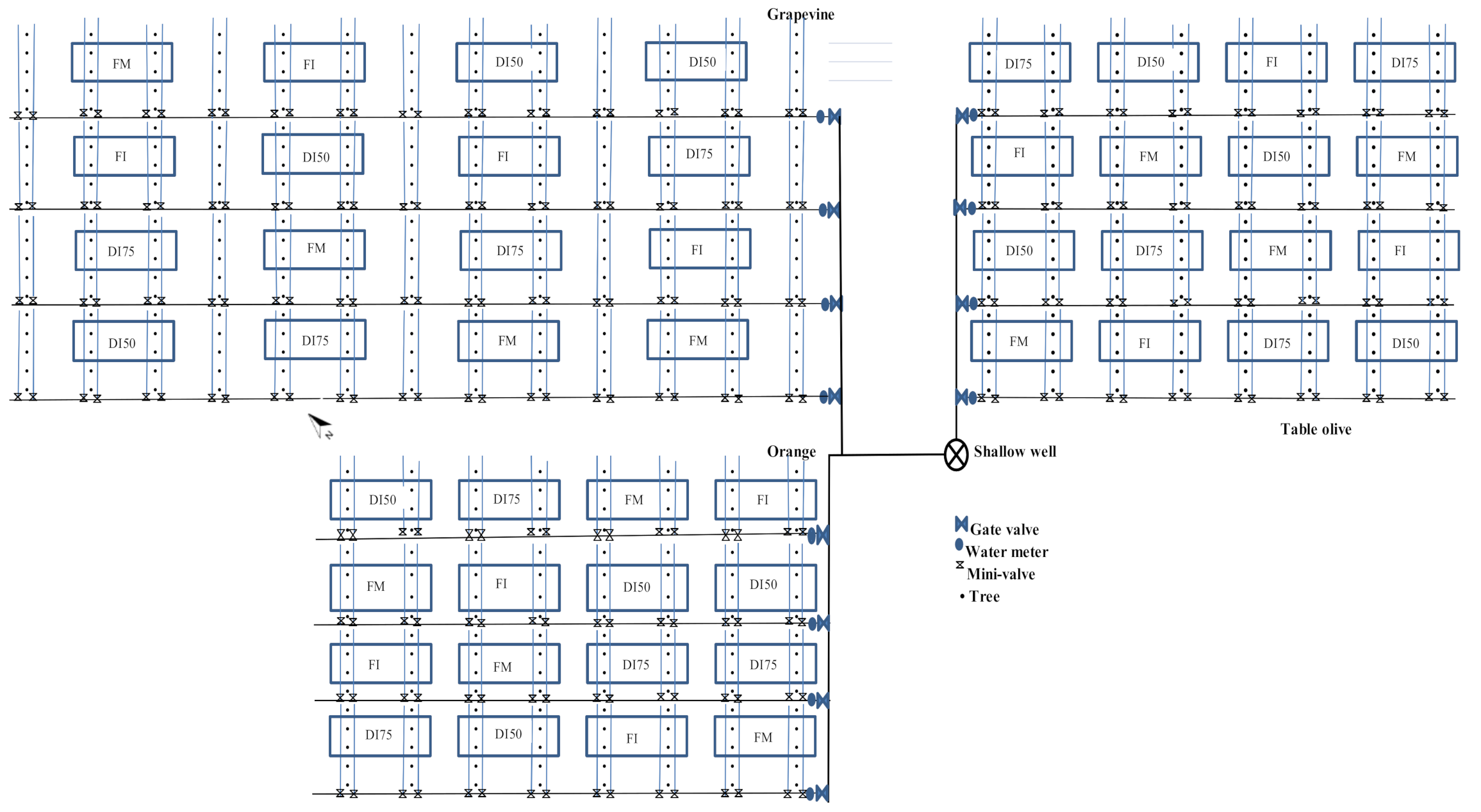
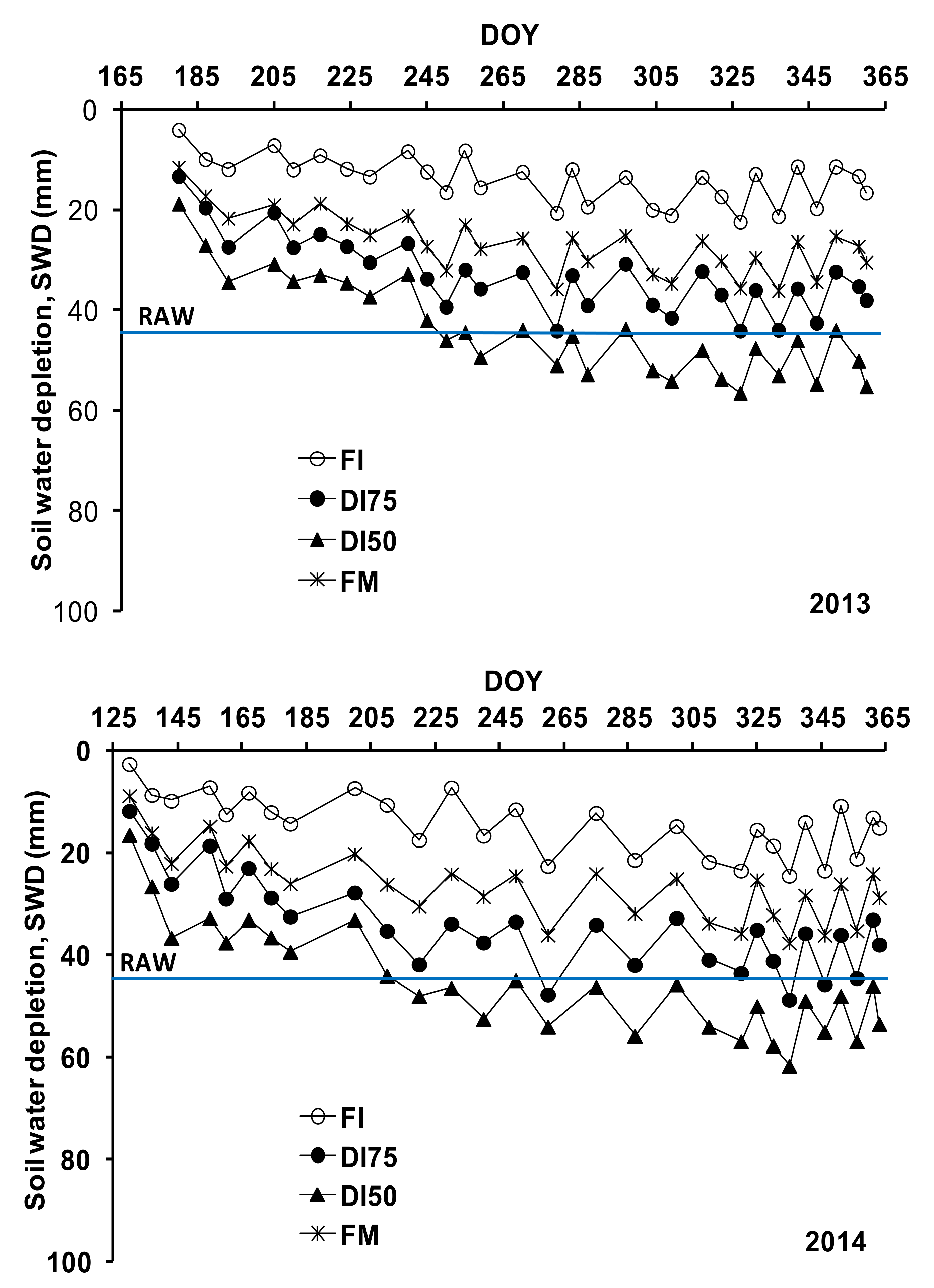
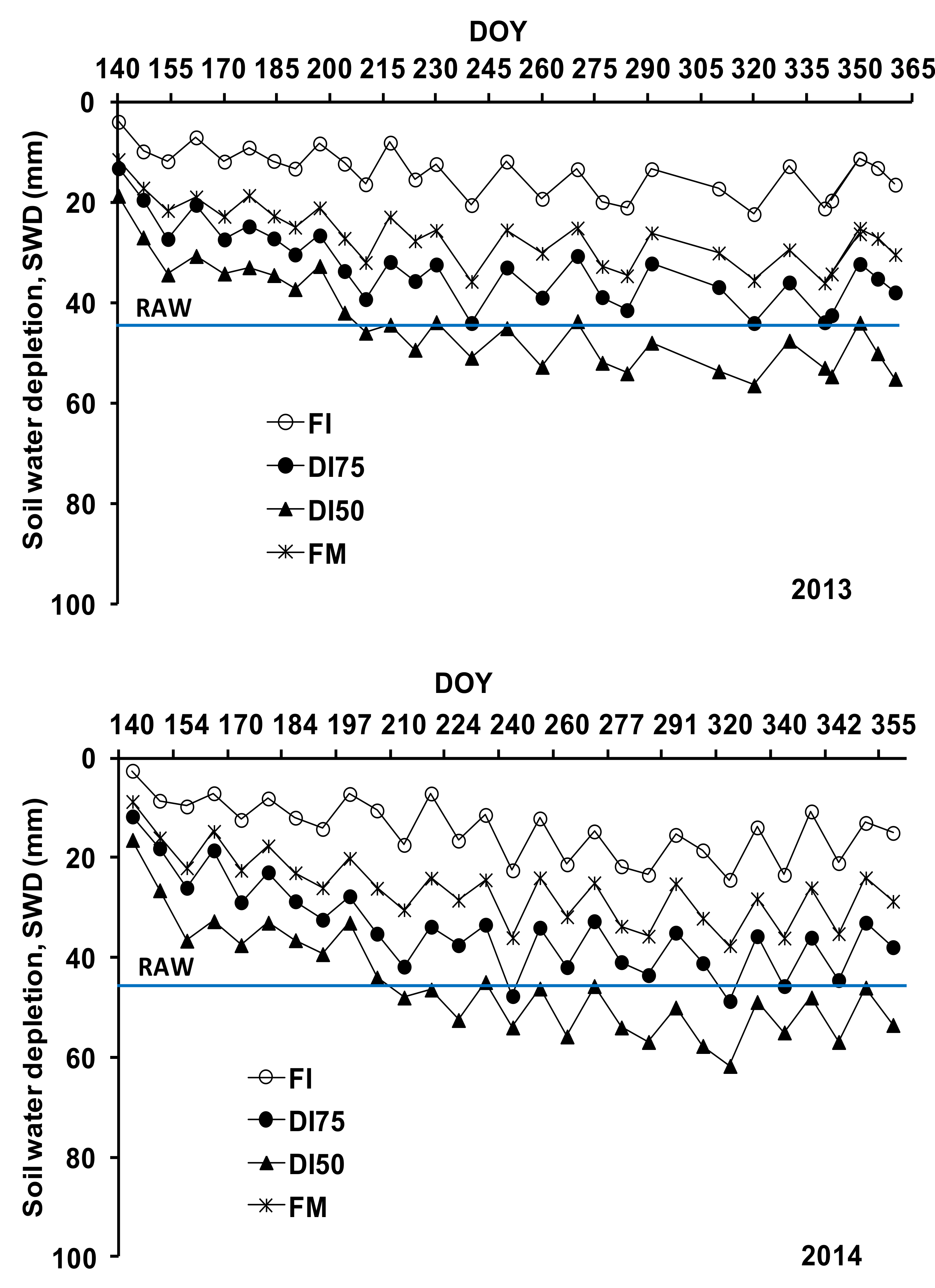
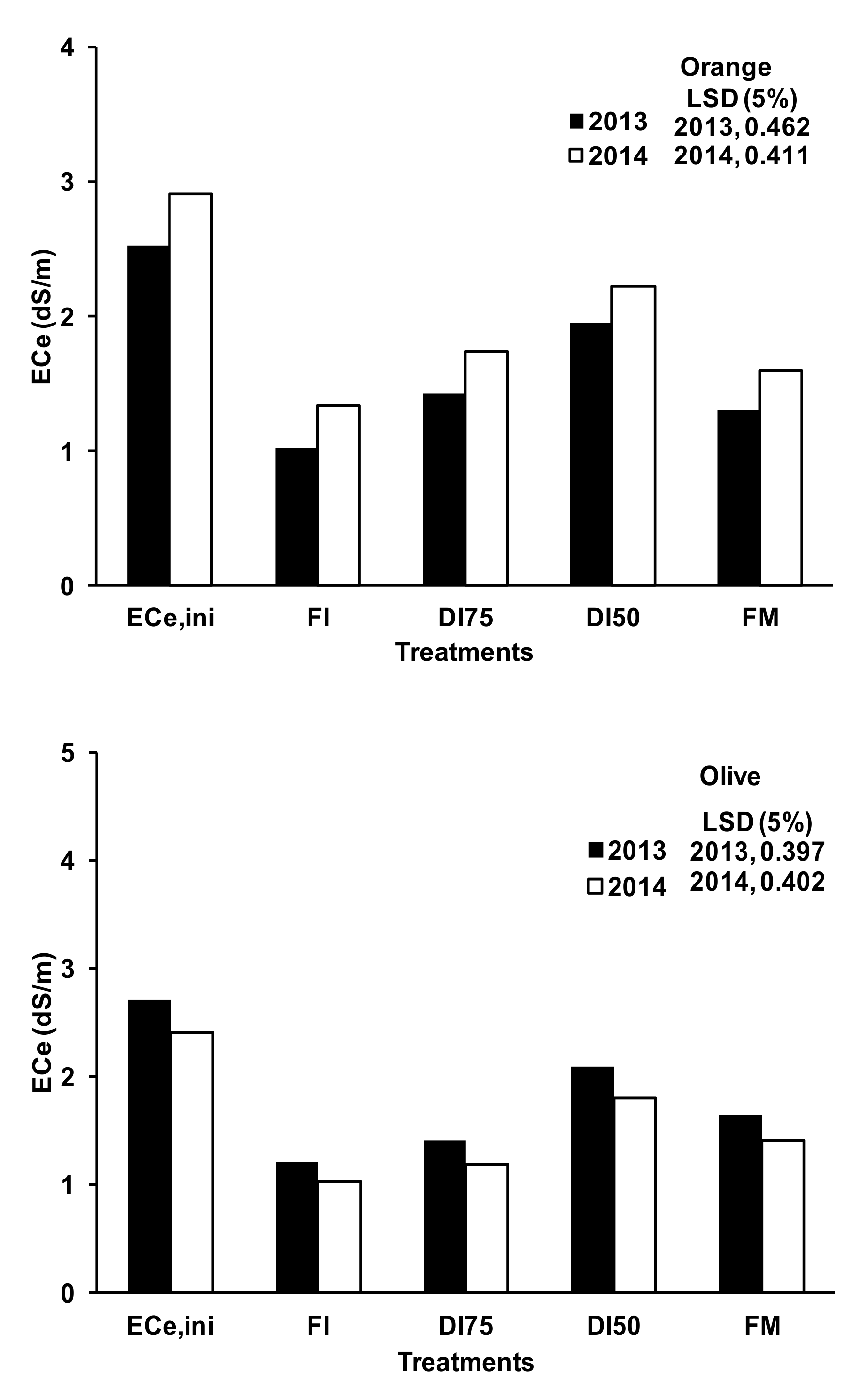
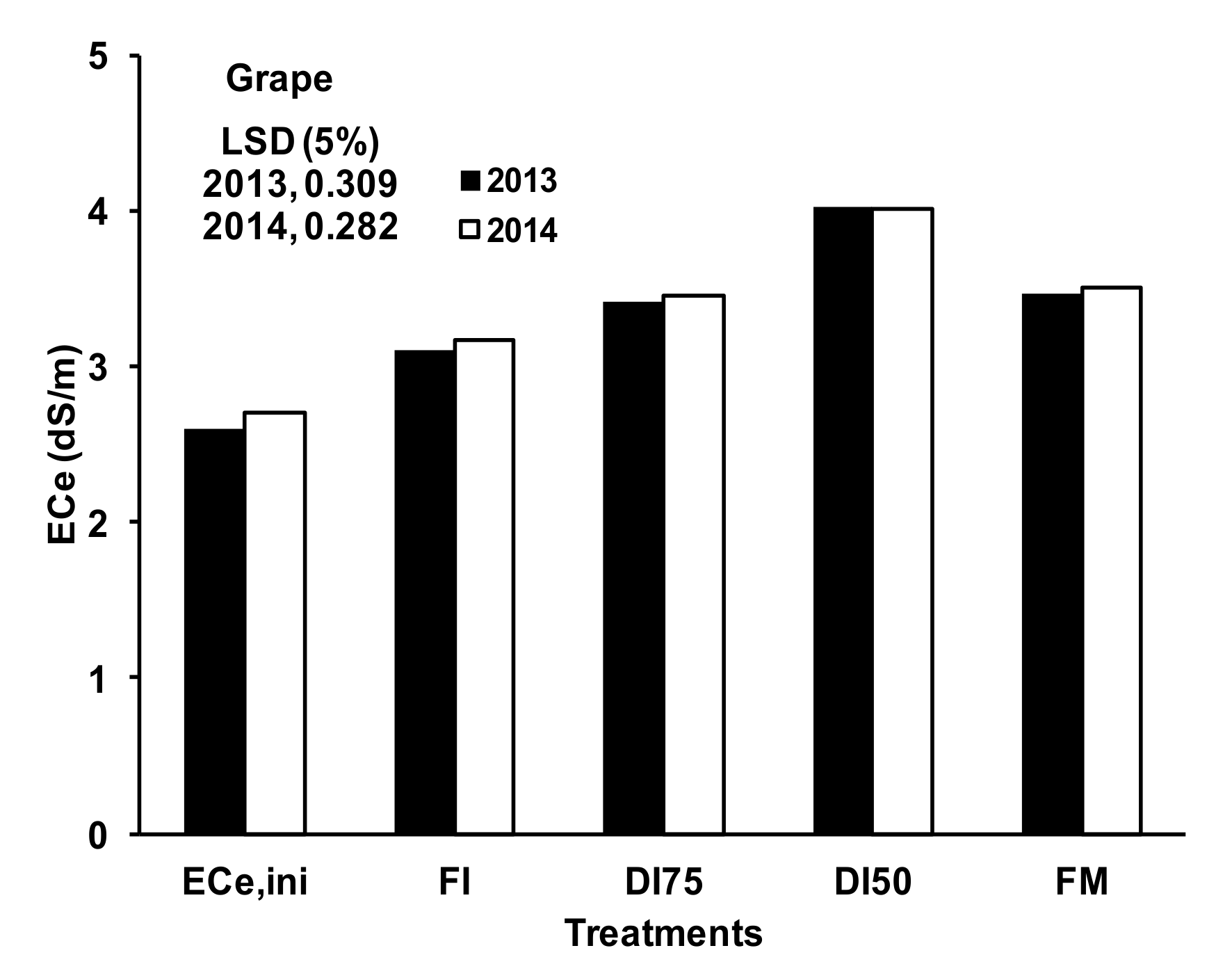
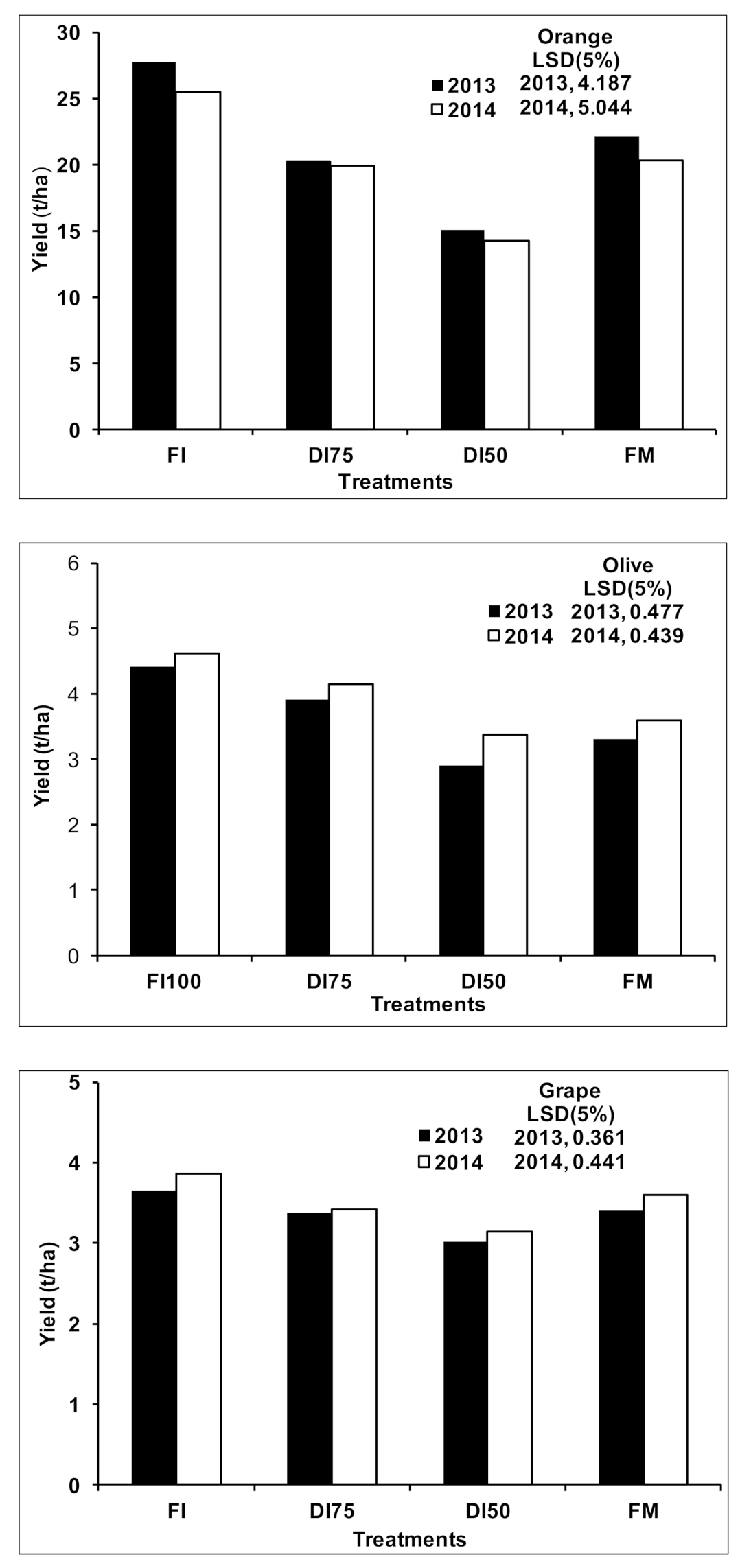

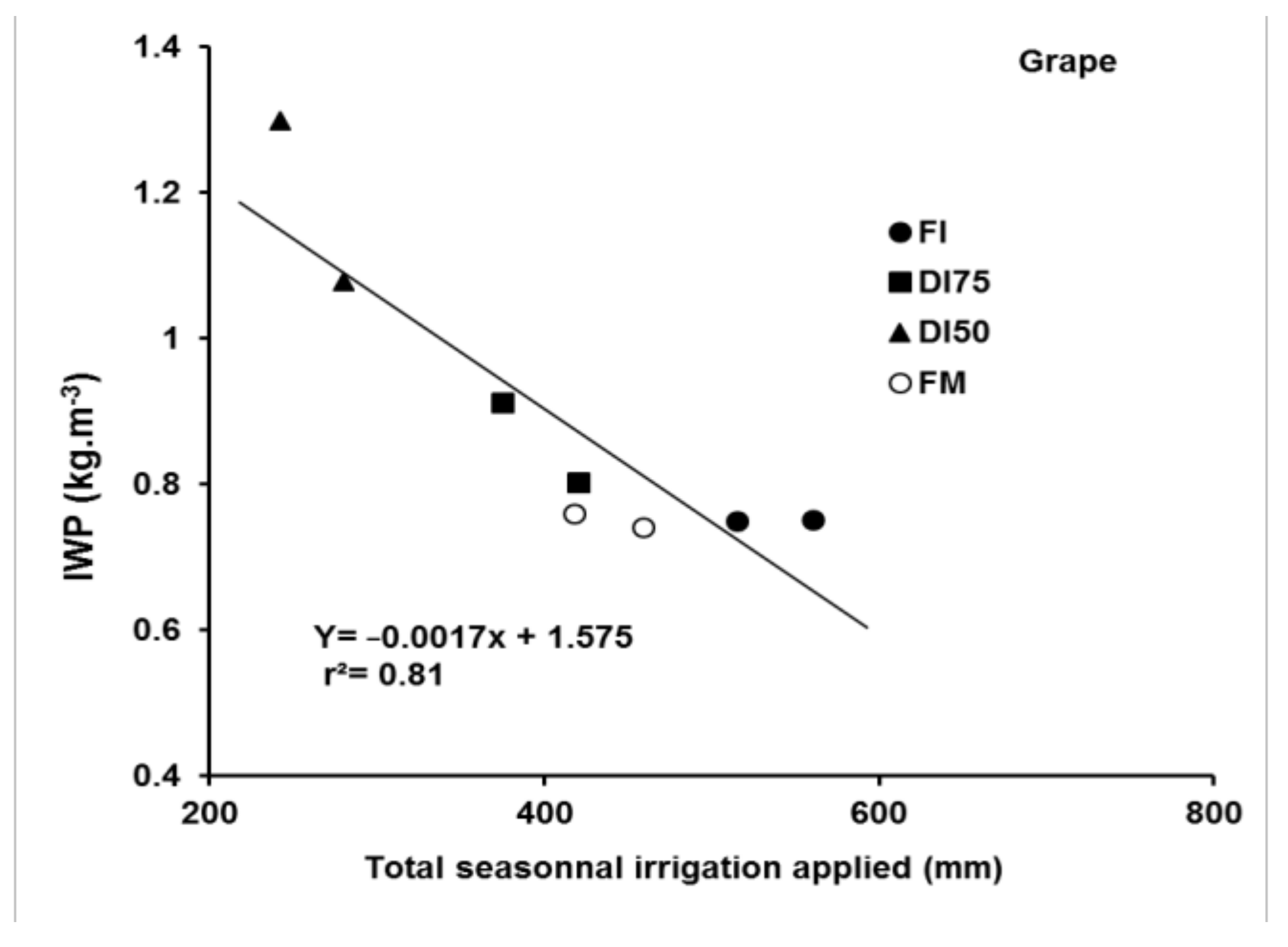
| Parameters | Fruit Weight (g/fruit) | TSS (°Brix) | Juice (%) | |||
|---|---|---|---|---|---|---|
| Year | 2013 | 2014 | 2013 | 2014 | 2013 | 2014 |
| FI | 298 | 295 | 10.6 | 11.6 | 64.7 | 65.8 |
| DI75 | 235 | 190 | 11.8 | 12.7 | 66.7 | 67.8 |
| DI50 | 177 | 166 | 12.6 | 13.4 | 64.3 | 65.1 |
| FM | 262 | 261 | 11.2 | 12.2 | 66.1 | 67.2 |
| LSD (5%) | 50.988 | 41.707 | 0.767 | 0.777 | 3.770 | 2.979 |
| Parameters | Fruit Weight (g) | Fruit Size (mm) | ||
|---|---|---|---|---|
| Year | 2013 | 2014 | 2013 | 2014 |
| FI | 5.49 | 6.01 | 18.50 | 19.93 |
| DI75 | 5.05 | 5.52 | 18.30 | 19.40 |
| DI50 | 4.08 | 4.59 | 16.50 | 16.98 |
| FM | 4.51 | 4.93 | 17.10 | 18.10 |
| LSD (5%) | 0.411 | 0.635 | 1.234 | 1.507 |
| Parameters | Berry Weight (g) | TSS (°Brix) | ||
|---|---|---|---|---|
| Year | 2013 | 2014 | 2013 | 2014 |
| FI | 9.3 | 9.72 | 19.6 | 20.7 |
| DI75 | 9.03 | 9.39 | 20.8 | 21.6 |
| DI50 | 8.33 | 8.52 | 21.6 | 22.7 |
| FM | 9.12 | 9.46 | 20.2 | 20.7 |
| LSD (5%) | 0.428 | 0.379 | 0.801 | 1.012 |
| Treatments | Orange | Table Olive | Grapevine |
|---|---|---|---|
| FI | 6.63 | 1.80 | 3.21 |
| DI75 | 3.94 | 1.40 | 2.79 |
| DI50 | 1.82 | 0.60 | 2.41 |
| FM | 4.34 | 0.84 | 2.90 |
Publisher’s Note: MDPI stays neutral with regard to jurisdictional claims in published maps and institutional affiliations. |
© 2021 by the authors. Licensee MDPI, Basel, Switzerland. This article is an open access article distributed under the terms and conditions of the Creative Commons Attribution (CC BY) license (https://creativecommons.org/licenses/by/4.0/).
Share and Cite
El Mokh, F.; Nagaz, K.; Masmoudi, M.M.; Ben Mechlia, N.; Ghiglieri, G. Deficit Irrigation Using Saline Water of Fruit Trees under Water Scarcity Conditions of Southern Tunisia. Atmosphere 2021, 12, 864. https://doi.org/10.3390/atmos12070864
El Mokh F, Nagaz K, Masmoudi MM, Ben Mechlia N, Ghiglieri G. Deficit Irrigation Using Saline Water of Fruit Trees under Water Scarcity Conditions of Southern Tunisia. Atmosphere. 2021; 12(7):864. https://doi.org/10.3390/atmos12070864
Chicago/Turabian StyleEl Mokh, Fathia, Kamel Nagaz, Mohamed Moncef Masmoudi, Netij Ben Mechlia, and Giorgio Ghiglieri. 2021. "Deficit Irrigation Using Saline Water of Fruit Trees under Water Scarcity Conditions of Southern Tunisia" Atmosphere 12, no. 7: 864. https://doi.org/10.3390/atmos12070864
APA StyleEl Mokh, F., Nagaz, K., Masmoudi, M. M., Ben Mechlia, N., & Ghiglieri, G. (2021). Deficit Irrigation Using Saline Water of Fruit Trees under Water Scarcity Conditions of Southern Tunisia. Atmosphere, 12(7), 864. https://doi.org/10.3390/atmos12070864







